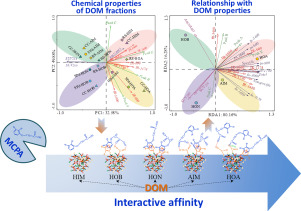当前位置:
X-MOL 学术
›
Sci. Total Environ.
›
论文详情
Our official English website, www.x-mol.net, welcomes your
feedback! (Note: you will need to create a separate account there.)
Characteristic of dissolved organic matter polar fractions with variable sources by spectrum technologies: Chemical properties and interaction with phenoxy herbicide.
Science of the Total Environment ( IF 8.2 ) Pub Date : 2020-03-27 , DOI: 10.1016/j.scitotenv.2020.138262 Dongming Wu 1 , Changqi Ren 2 , Lei Jiang 1 , Qinfen Li 1 , Wen Zhang 2 , Chunyuan Wu 1
Science of the Total Environment ( IF 8.2 ) Pub Date : 2020-03-27 , DOI: 10.1016/j.scitotenv.2020.138262 Dongming Wu 1 , Changqi Ren 2 , Lei Jiang 1 , Qinfen Li 1 , Wen Zhang 2 , Chunyuan Wu 1
Affiliation

|
Dissolved organic matter (DOM) is ubiquitous with high biological and chemical activity. The large intake of DOM from compost, plant residues or soil can modify the behaviors of agrochemicals. Phenoxy herbicide is the third widely used herbicide around the world with both aromaticity and polarity. However, how the diverse fractions of DOM interacting with phenoxy herbicide and the underlying mechanisms remain unknown. Thus, it is crucial to investigate the heterogeneous chemical properties of DOM fractions from variable sources and explore the interactive mechanisms. In this study, polar DOM derived from compost, rice straw and soil were fractionated, and the chemical properties of fractions were analyzed by spectrum technology and the complex interaction with phenoxy herbicide was assessed by infrared spectroscopy. Results showed that hydrophobic acid (HOA) was the largest component (49.6%) in compost DOM, while hydrophilic matter (HIM) was the main component in the polar DOM from rice straw and soil. The 4-chloro-2-methylphenoxyac etic acid (MCPA) as one representative of phenoxy herbicides was used in our study, and the results showed the interaction between different DOM fractions and MCPA was heterogeneous. HOA containing abundant fulvic-like component and polar groups resulted a greatly complex interaction with MCPA mainly via hydrophobic force, ligand exchange and hydrogen bonding. Hydrophobic neutral fraction and acid-insoluble matter showed a medium interaction with MCPA as a result of enrichment with the high aromatic humic-like molecules. Inversely, no significant interaction between HIM and MCPA was observed. Our research revealed that the aromatic framework associated with polar groups in DOM dominated the interaction with phenoxy herbicide, which might affect the bioavailability, toxicity, and mobility of phenoxy herbicide.
中文翻译:

通过光谱技术分析具有可变来源的溶解有机物极性馏分的特征:化学性质和与苯氧基除草剂的相互作用。
溶解性有机物(DOM)具有很高的生物和化学活性。从堆肥,植物残渣或土壤中摄入大量的DOM可改变农药的行为。苯氧基除草剂是世界上第三种同时具有芳香性和极性的广泛使用的除草剂。但是,尚不清楚DOM的不同部分如何与苯氧基除草剂相互作用以及其潜在机理。因此,至关重要的是研究来自可变来源的DOM馏分的异质化学性质并探索相互作用机制。在这项研究中,对来自堆肥,稻草和土壤的极性DOM进行了分级,并通过光谱技术分析了级分的化学性质,并通过红外光谱法评估了与苯氧基除草剂的复杂相互作用。结果表明,疏水性酸(HOA)是堆肥DOM中最大的组成部分(49.6%),而亲水性物质(HIM)是稻草和土壤中极性DOM中的主要组成部分。本研究以4-氯-2-甲基苯氧基乙酸(MCPA)为代表的苯氧基除草剂,结果表明,不同的DOM组分与MCPA之间的相互作用是异质的。HOA含有丰富的富勒维样成分和极性基团,主要通过疏水力,配体交换和氢键作用,导致与MCPA的相互作用非常复杂。疏水性中性级分和酸不溶性物质由于富含高芳族腐殖质分子而显示出与MCPA的中等相互作用。相反,在HIM和MCPA之间没有观察到明显的相互作用。
更新日期:2020-03-27
中文翻译:

通过光谱技术分析具有可变来源的溶解有机物极性馏分的特征:化学性质和与苯氧基除草剂的相互作用。
溶解性有机物(DOM)具有很高的生物和化学活性。从堆肥,植物残渣或土壤中摄入大量的DOM可改变农药的行为。苯氧基除草剂是世界上第三种同时具有芳香性和极性的广泛使用的除草剂。但是,尚不清楚DOM的不同部分如何与苯氧基除草剂相互作用以及其潜在机理。因此,至关重要的是研究来自可变来源的DOM馏分的异质化学性质并探索相互作用机制。在这项研究中,对来自堆肥,稻草和土壤的极性DOM进行了分级,并通过光谱技术分析了级分的化学性质,并通过红外光谱法评估了与苯氧基除草剂的复杂相互作用。结果表明,疏水性酸(HOA)是堆肥DOM中最大的组成部分(49.6%),而亲水性物质(HIM)是稻草和土壤中极性DOM中的主要组成部分。本研究以4-氯-2-甲基苯氧基乙酸(MCPA)为代表的苯氧基除草剂,结果表明,不同的DOM组分与MCPA之间的相互作用是异质的。HOA含有丰富的富勒维样成分和极性基团,主要通过疏水力,配体交换和氢键作用,导致与MCPA的相互作用非常复杂。疏水性中性级分和酸不溶性物质由于富含高芳族腐殖质分子而显示出与MCPA的中等相互作用。相反,在HIM和MCPA之间没有观察到明显的相互作用。










































 京公网安备 11010802027423号
京公网安备 11010802027423号